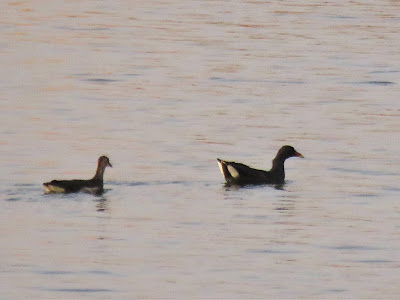The term Wadi means a dry river bed and at the northern end of my walk it certainly lived up to its name. The area had a landscaped appearance with trees and some bushes spaced out along the channel where the river would run. On done side is a fairly busy road and above that a high sandstone cliff and a very high wall with small castle keep like structures dotted along it. I think this was to keep rocks from the cliff falling on the road. The cliff at the first location was about 50 meters high and made of a kind of sandstone rock common around here. It has a layered appearance with vertical cracking which makes it look like a layered cake. Some of the cracks were quite big and I could not help thinking they would be ideal places for owls and rock dove to nest. On the opposite side were more high walls behind which were date farms. I have a feeling that this whole area could get pretty lively when the weather turns and we get rain.
I had literally just arrived and was stepping out of the car when I spotted a red beak in trees. On closer inspection I found a Rose Necked Parakeet perched on a branch and within moments had spotted another 5. Wonderful birds though, as with their cousins in the South of England, not natives to Saudi Arabia. As with a number of birds here they originate from cages from which they were either released or escaped. In any event they appear to be doing well, who knows maybe in ten years or so there will be ten thousand of them like there are in London.
This site is certainly one for Hoopoe viewing. I spotted at least 10 along the length of the wadi. Most looked like relatively young birds and they allowed fairly close approach by comparison with those at Al Hayer. I think I saw more of these today than I have over the past three years.
Lurking about the place were a small number of Collared Doves. You do see quite a few of these around Riyadh but never in large numbers.
Another very common sight along the Wadi was the Common Myna which were everywhere. I can't remember the count exactly but there were 40+ in the couple of miles I travelled today.
This weaved nest in interesting and is similar to a couple I saw in a tree about 60 meters away. They were similar but hanging by a string of grass from the branch. There are definitely some weavers breeding about the area and not the usual Streaked Weavers we see at Al Hayer. This is an altogether different type of nest.
As I approached the flyover I spotted a number of birds feeding on the seeds of the long grass stems. They all flushed but thankfully stopped in a tree only a short distance away. A nice little flock of Indian Silverbills.
As is always the case when your birding, you go on one side of the river the birds are all on the other side! I noticed this guy having a dust bath and watched for a while. A very nice Rufous-Tailed Scrub Robin.
I flushed this Squacco Heron from the trees by the side of the Wadi. Only got a fleeting photo before he disappeared
As always there was a good number of White Eared Bulbul about the area.
and large numbers of House Sparrow.
This is my first trip to the area and certainly will not be my last as there are a number of things I want to follow up, like the owner of those nests for a start. There is a lot more of the Wadi than the bit I managed to navigate today so will be back! :)





























































